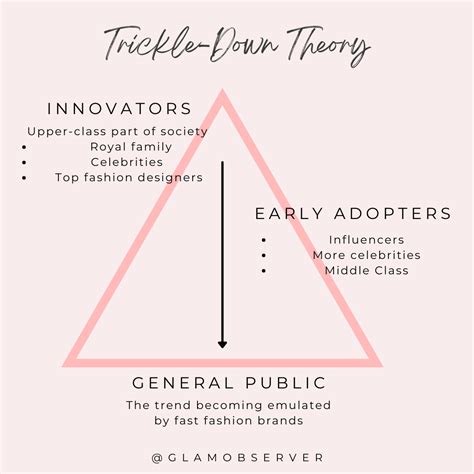louis vuitton trickle down veblen | trickle down theory fashion louis vuitton trickle down veblen Coined in 1899 by American economist and sociologist Thorstein Veblen, the ‘trickle-down theory’ is based on the idea that fashion is a . Froosh Smoothie Mango & Orange. Meet alphonso, the rolls-royce of mangos and the secret weapon to our best-seller. A perfect snack in any situation, for example breakfast, after training or when you are in need of a snack, either on-the-go or at home.
0 · why is trickle down happening
1 · trickle down theory fashion
2 · trickle down theory
Since November 1999, patients at our institution requiring adjuvant 5-FU/leucovorin (LV), if not entering a clinical trial and considered fit by their clinician for full-dose chemotherapy, have been prescribed once-weekly bolus 5-FU plus LV, for 24 weeks.
Coined in 1899 by American economist and sociologist Thorstein Veblen, the ‘trickle-down theory’ is based on the idea that fashion is a . The trickle-down theory in fashion occurs because not everyone can afford luxury brands like Louis Vuitton. When Arclight sneakers were introduced, they were priced at . Coined in 1899 by American economist and sociologist Thorstein Veblen, the ‘trickle-down theory’ is based on the idea that fashion is a hierarchal industry. In ‘The Theory of the Leisure Class’, Veblen identified that clothing was a key element used by upper classes to differentiate themselves as elite. He argued that the status-seeking of the elite (with their ‘trophy wives’) has a destructive trickle-down effect to the lower classes. This is known as the Veblen Effect. It results in low investment in the real economy, conspicuous consumption and limited entrepreneurship.
The trickle-down theory in fashion occurs because not everyone can afford luxury brands like Louis Vuitton. When Arclight sneakers were introduced, they were priced at approximately 90,000 rupees. As the trend trickled down to Balenciaga, the price decreased to approximately 68,000 rupees. A Louis Vuitton / Supreme boxed logo t-shirt recently sold for ,750. The shirt was produced by Supreme, which originally sold it for 5. You may think that this item is an anomaly, but it.
The theory of conspicuous consumption holds that wealthy individuals consume luxury goods to display their affluence and to signify status (Veblen 1899). The trickle-down theory posits that, in attempts to emulate these individuals, the masses in lower social classes adopt and mimic the trends of the upper class individuals (Simmel 1957 ). Bandwagon and trickle-down effects (in addition to trickle-up and trickle-across diffusions; Atik and Firat 2013), where elite consumers integrate a particular element into their luxury purchase that filters down to less affluent users (Cervellon and .

louis vuitton stemma
His boutique in Harlem, open from 1982 to 1992, initially sold leather and fur coats to gangsters and hustlers of the neighbourhood, but everything changed when one of the biggest drug dealers in Harlem walked into the boutique with a . To understand why consumers would buy ugly luxury products, recent perspectives in consumer research have opened avenues for alternative explanations in line with the trickle-down-effect theory (Simmel, 1957, Veblen, 1899). Veblen goods, such as the items sold by LVMH, are rarely cyclical. But why's that? Well, the theory behind it is that the more expensive the products get, the more demand rises. The Louis Vuitton “Speedy” bag, Burberry checked scarf, and nearly all quilted Chanel bags all share one thing in common: They have all become so widely counterfeited to the point where one cannot distinguish the real from the fake.
Coined in 1899 by American economist and sociologist Thorstein Veblen, the ‘trickle-down theory’ is based on the idea that fashion is a hierarchal industry. In ‘The Theory of the Leisure Class’, Veblen identified that clothing was a key element used by upper classes to differentiate themselves as elite. He argued that the status-seeking of the elite (with their ‘trophy wives’) has a destructive trickle-down effect to the lower classes. This is known as the Veblen Effect. It results in low investment in the real economy, conspicuous consumption and limited entrepreneurship. The trickle-down theory in fashion occurs because not everyone can afford luxury brands like Louis Vuitton. When Arclight sneakers were introduced, they were priced at approximately 90,000 rupees. As the trend trickled down to Balenciaga, the price decreased to approximately 68,000 rupees. A Louis Vuitton / Supreme boxed logo t-shirt recently sold for ,750. The shirt was produced by Supreme, which originally sold it for 5. You may think that this item is an anomaly, but it.
The theory of conspicuous consumption holds that wealthy individuals consume luxury goods to display their affluence and to signify status (Veblen 1899). The trickle-down theory posits that, in attempts to emulate these individuals, the masses in lower social classes adopt and mimic the trends of the upper class individuals (Simmel 1957 ).
Bandwagon and trickle-down effects (in addition to trickle-up and trickle-across diffusions; Atik and Firat 2013), where elite consumers integrate a particular element into their luxury purchase that filters down to less affluent users (Cervellon and .
His boutique in Harlem, open from 1982 to 1992, initially sold leather and fur coats to gangsters and hustlers of the neighbourhood, but everything changed when one of the biggest drug dealers in Harlem walked into the boutique with a . To understand why consumers would buy ugly luxury products, recent perspectives in consumer research have opened avenues for alternative explanations in line with the trickle-down-effect theory (Simmel, 1957, Veblen, 1899). Veblen goods, such as the items sold by LVMH, are rarely cyclical. But why's that? Well, the theory behind it is that the more expensive the products get, the more demand rises.
why is trickle down happening

Froosh, Kópavogur. 52,850 likes. Froosh - bara ávextir, ekkert annað!
louis vuitton trickle down veblen|trickle down theory fashion


























